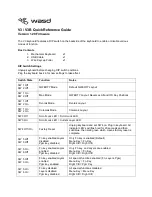
|
7
KeyRIg 49 User Guide
The KeyRig 49 Keyboard
8
Key Names
The letters printed above the white keys stand for the names of the musical notes the keys represent. The number next to each
letter marks the octave each key belongs to (More information on octaves can be found in the following section ) Black keys are
“semitones” to their adjacent white keys and don’t have a dedicated letter. A semitone represents the distance in pitch from one note
to its immediate neighbor
Black keys usually have the same name as the next higher or lower white key, but have an additional sharp symbol (# – semitone
higher than the letter indicates), or flat symbol (b – semitone lower than the letter indicates) attached to them. For example, the name
of the black key to the right of C3 is C#3 (C-sharp 3), but it can also be called Db3 (D-flat 3), since it is also adjacent to the D key
on its right. In other words, black keys have two valid names, depending on the context of the musical notation they are part of.
Octave Buttons
An octave contains 12 notes, and each octave is marked out clearly on your KeyRig 49 keyboard by black and white sections starting
on C. Each octave is given a number.
KeyRig 49 is able to shift the pitch of its keys up or down by one or more octaves When the keyboard’s octaves are not shifted
(octave shift set to zero), the lights above both the Octave “<” and Octave “>” buttons will be lit. The default octave shift designation
is zero and will be the octave setting each time you power up the keyboard
If you press the Octave “>” button once, the light above the Octave “<” button will go out, indicating the keyboard is now playing
an octave higher. If you press the Octave “>” button again, the keyboard will be shifted up two octaves. It is possible to shift the
keyboard up a total of four octaves using the Octave “>” button. To shift the octave down, press the Octave “<” button in the same
manner: pressing once for one octave, twice for two octaves, and three times for three octaves. It is possible to shift the keyboard
down a total of three octaves
To return the keyboard’s octave shift to zero, press both the Octave “<” and “>” buttons at the same time. Both LEDs will light,
indicating that the octave shift has returned to zero. In summary, when the Octave buttons are set to control octave shift (default), if
the light is only lit above the Octave “>” button, the octave is shifted up. If the light is only lit above the Octave “<” button, the octave
is shifted down
Pitch Bend Wheel
As the name indicates, the Pitch Bend wheel is usually used to bend the notes played on the keyboard up or down This allows you
to play phrases not normally associated with keyboard playing, including guitar-style riffs Your sound source determines how far you
can bend the note The usual setting is two semitones but can be up to two octaves up or down









































